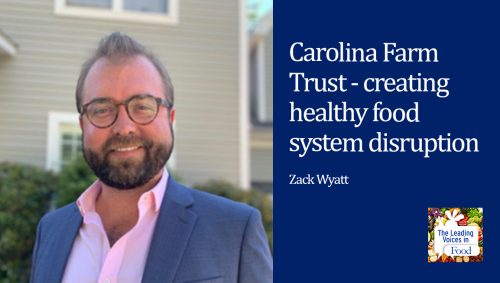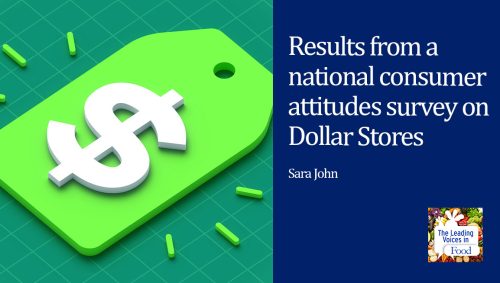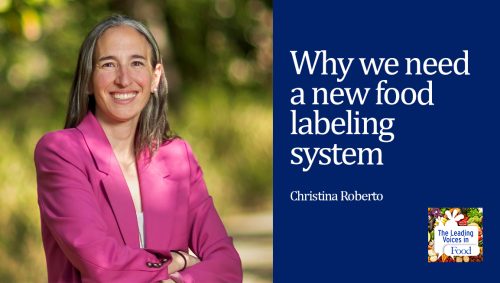E135: How did SNAP do during COVID and What Changes Need to Stay?
The COVID-19 pandemic changed our lives and led to mandated business and school closures, families and communities all around the country experienced record levels of unemployment and record levels of food insecurity. This led to unprecedented policy innovation designed to increase access to nutritious food through the supplemental nutrition assistance program, known as SNAP. The program that was formerly known as Food Stamps. In today’s podcast, we’ll talk with the authors of a new report entitled, Supplemental Nutrition Assistance Program Waivers and Adaptations During the COVID-19 Pandemic, A Survey of State Agency Perspectives in 2020.
Subscribe: Apple Podcasts | TuneIN | Google Podcasts | SoundCloud | PocketCasts | Radio Public
Tags: COVID-19 Pandemic Impacts on Food | Food Insecurity | Food Policy | Social Safety Net & Food |

Alyssa Moran has more than a decade of experience working with individuals, community organizations, and government agencies on food and nutrition programs and policies. Currently, she is an Assistant Professor of Health Policy at the Johns Hopkins Bloomberg School of Public Health, where she is Core Faculty within the Institute for Health and Social Policy and Impact Specialist in Obesity and the Food System. Her research, teaching, and practice focus on the role of food and social policies in improving diet quality, reducing food insecurity, and eliminating health inequalities. She is a registered dietitian, earned her MPH in public health nutrition from NYU in 2011, and earned her ScD in nutrition from the Harvard Chan School of Public Health in 2018.
Matt Lyons is the Director of Policy and Research with the American Public Human Services Association (APHSA). In his role, Matt is responsible for developing and executing strategies for policy advocacy and influence in areas impacting health and human services programs. Prior to joining APHSA, Matt served in a variety of roles in state and local government, including administering economic support programs for Maryland’s human services agency, managing disaster recovery programs for the State of New Jersey in response to Superstorm Sandy, and coordinating the delivery of housing and healthy homes programs for the Baltimore City Department of Housing & Community Development. Matt also has worked for a non-profit research institute where he provided technical assistance, data analysis, and information system design and implementation for low-income energy efficiency and community services programs across the country. Matt has an undergraduate degree in Government and Politics and a Master of Public Policy from the University of Maryland.
Interview Summary
Our guests today are two of the authors of the report, health policy expert, Alyssa Moran of the Johns Hopkins Bloomberg School of Public Health, and Matt Lyons, the Director of Policy and Research with the American Public Human Services Association. So your report addressed how states responded to the increase in need for SNAP during the pandemic. Matt let’s begin with you, can you tell us more about the report and why it was important to document the state experiences?
When the pandemic first hit last year, the sharpest spike and need for basic help was in SNAP. And this isn’t a typical and economic downturn SNAP has always been one of the most effective tools to help meet people’s basic needs and to stimulate local economies. This time around though, we had to weather an economic crisis that was layered on top of a public health crisis, and that dynamic raised all kinds of new questions about how state agencies were going to get help to millions of families in a world that literally shifted to virtual overnight. In those first weeks of the pandemic, we as the membership association supporting those state agencies, we were literally convening state agency leaders on Zoom calls daily just to figure out basic questions of how are you going to keep the lights on so that staff could keep processing applications when they’re working from home? Or how are you going to navigate through federal requirements that frankly were developed at a time when SNAP was assumed to be a program people applied for in person? And as difficult as that was for our agencies to make sense of, we could only imagine how infinitely harder that was for all of the people that were trying to apply for help. So as federal policies and guidance started to catch up in the coming weeks and months, and states really settled in for the long-term COVID response, states had to plan for how they’re going to adapt their services so that people could keep accessing the benefits through the duration of the pandemic. And as we worked through all of these monumental changes to how the program is being administered, it really just became self evident that it was crucial. We had to take the time to rigorously document this experience and just draw on all the insights and lessons learned so that we can improve access to SNAP in the long-term and strengthen its impact on peoples and communities based off of this experience.
Well, some of the problems, the challenges you mentioned make perfect sense now that you’ve brought them up, but they’re not the kind of thing most people would think about, and you could imagine how hard it must’ve been to keep things going that even a modest level, much less been ramped up. So Alyssa, I’d like to hear your thoughts on this.
I’ll preface this by saying that I’m a public health researcher. So I think about SNAP through that lens, and from a public health perspective, SNAP is a tremendously important program. It reaches about one in eight Americans and nearly half of those participants are kids. And it’s a critical program for reducing poverty and improving food security, which are really important social determinants of health affecting everything from dental caries to diabetes, to depression. But the design and the delivery of SNAP also really better for health. For example, there are obvious ways that design choices in SNAP affect health equity, things like eligibility criteria, which prevent certain people from accessing the program or decisions about the benefit amount, which affects the types of foods that are available to participants. But there are also more subtle ways that program delivery can impact health, something as simple as how the state communicates with you about your benefits. So did they send you a text message right to your phone, or do you have to call a call center and wait on the line for two hours for information? Can you submit all of your application information online or do you have to come into the office for an in-person interview? So all of these requirements to enroll and stay enrolled in SNAP can affect health by limiting or expanding access to benefits and can also cause significant stress, increased anxiety and cause people to worry about whether they’re even going to actually receive their benefits each month. And as Matt described, the pandemic acutely changed how states deliver SNAP and how participants interact with the program. And I was really interested in learning what we can take away from this experience to strengthen the public health impact of SNAP moving forward, not just by breaking down barriers to access, but also by improving the client experience through these structural changes.
It’s nice to hear of the interest among public health researchers in helping improve the delivery of these programs, because as you said, they reach so many people. Matt, you mentioned that there were program changes that needed to be made in SNAP during the pandemic, how successful do you think these changes really were in helping states serve their clients?
Well, in those first few months of the pandemic, you had more than 6 million people newly enrolled in SNAP and participation has remained well above pre pandemic levels as a nation have continued to grapple with all of the disparities in the COVID response and recovery. So I think from this perspective alone, it’s important to consider the SNAP pandemic response a success. Fundamentally more people needed help affording food during the pandemic and the program was responsive. We’ve all heard the stories of it taking weeks, if not months for unemployment insurance systems to respond to the spike in demand and to be able to issue new benefits. And that just wasn’t the case for SNAP. State and local agencies really did step up to the table to meet the challenge, but I will say SNAP’s ultimate success, it certainly didn’t come without its fair share of bumps in the road. And I think that probably starts with the fact that SNAP rules, they’re just not well suited to work in a virtual world. When you think of things like interview requirements and procedures for recertifying for benefits and even things like a signature requirement, they all lean heavily on in-person interaction. And that’s particularly true for underserved communities that already face access barriers.
For our clients, if you mess up and following those rules, you’re back to square one, you got to start all over in the application process and even beyond just the benefit itself, there’s other components of SNAP that are there to help people receiving a help learn more about healthy food or engage in employment and training services. And those services are similarly modeled towards in-person activities. So to say that the program had to make changes would be an understatement, I really think everything had to change about SNAP. And I will say to their credit, the federal government approved a broad range of temporary flexibilities to mitigate a lot of these issues.
But really, the devil is in the detail of whether these flexibilities can be successfully implemented. Early in the pandemic in particular, states would often not get approval for waivers that were really critical to help families keep their benefits until days before or even after an action was due in a client’s case. The reality is that states needed to know weeks in advance. They could be updating their eligibility systems and sending out notifications to people receiving SNAP of what was expected of them. And these issues unquestionably led to unnecessary confusion and problems in the pandemic response. I will say fortunately, the federal government did learn from a lot of its early mistakes, in late September Congress passed new legislation that allowed for a lot more flexibility in states being able to select waivers, they could deploy over a longer time horizon and customized to their specific needs and implementation approaches. And that approach, it worked a lot better for states to be able to proactively plan how they could use these waivers and transition over time to a new normal. In the months after that even both Congress and the administration made a number of additional changes to help states provide more equitable benefits access. So I would say even in just the short period of this pandemic response, we’ve already come a long ways.
Alyssa, I’d appreciate your reflections on this issue as well.
The pandemic really forced states to think differently about how they interact with and provide services to clients. Some of those changes were successful and others existing deficits in technology, staffing models or community partnerships that were really difficult or sometimes even impossible to adapt during the national crisis. So one example of a change that worked well was the expansion of telephonic case processing. So this allows caseworkers to support client applications over the phone instead of in-person or online. And federal policy really facilitated that by allowing clients to give verbal signatures over the phone instead of a written signature. Before the pandemic, states had some options to do this, but they were required to collect and store an audio recording of the signature and purchasing that technology to be able to do that was a major barrier. So only some states were doing it and it wasn’t always fully available statewide. So this flexibility that allowed for verbal signatures was seen as a really successful low-cost option facilitating remote services.
Another change I’d consider successful was the expansion of the online purchasing pilot. So before the pandemic, only two states allowed SNAP participants to use their benefits for online groceries, and now almost all 50 states offer that service. And we know that there are still a number of barriers to access, so things like few participating retailers, high delivery and service fees, lack of delivery particularly in rural areas, but it does represent a big shift towards modernizing SNAP, which was long overdue. On the flip side states also experienced some challenges moving SNAP online, particularly in communicating these frequent program changes to clients, shifting supportive services like nutrition, education, and workforce training to a virtual setting and engaging people who might lack reliable access to internet or digital devices. Very few states were able to provide mobile friendly services to clients, most relied on mass communication through their websites or social media or call centers. And even though most states were able to transition their supportive services online, somewhat, they tended to have difficulty engaging clients in this new setting.
So you both painted a picture of things that may be helpful to know in the future if there’s some crisis like the COVID-19 pandemic, but also there’s a lot to be learned about the way SNAP might be changed going forward overall no matter what’s happening in the background. So Matt, let me ask, what are you taking away from this experience about making SNAP stronger and more resilient?
Well, I think that’s the million dollar question. So the first thing I think that sticks out to me, we really desperately need a playbook ready to go should we ever face a crisis like this again. The time it took to get legislative authority from Congress so we could get SNAP rules adjusted and then the process of developing and refining USDA Guidance has a real insignificant cost on the people in the communities that need help. Being able to come into a crisis where we’ve codified automatic triggers that are most essential for SNAP to be responsive during a time of crisis that would really ensure that state and local agencies can hit the ground running with a plan and knowledge of what flexibilities they can use and how to best deploy them. This is needed around a lot of different issues.
I’d say most glaringly, we need to be talking about SNAP benefit increases and looking at suspending work requirements during a crisis, but we also need to look at those administrative rules that make a really big impact on how people access and participate in services. So things like interview requirements, the way that people can recertify for benefits, the use of telephonic signatures, quality control procedures, and then things for particular populations that have specific needs, looking at student eligibility rules, purchasing of hot and prepared foods. These all come to mind to me as things that we really need to come prepared day one of whatever that next crisis is to be ready to respond, to be nimble and adaptive.
The second thing that sticks out to me is we have learned a tremendous amount about what works and what doesn’t work in SNAP this past year, and we should use it to strengthen the program. Many states have found that the amount of meetings and paperwork that we’re required to put people through, it really does little to preserve program integrity. What it does do is it places a lot of significant administrative burden on families. So less rigid interviews and change reporting requirements can help us cater the program to better support people that are participating. And I think federal pilots demonstrations that could test alternative strategy that could help states build the evidence for what best practices work and what contexts, that’s really needed right now and the time is critical that we be thinking about that as we transition out of the pandemic.
Thanks, Matt. And Alyssa, what are your thoughts on this?
Testing ways to minimize participant burden is really critical. And what we’ve learned during the pandemic is that a big part of that is investing in technology to expand the ways that people can interact with SNAP. So one example that I think is helpful is thinking about what it’s like to do your taxes now versus what that looked like even 10 years ago. So if you recall, you used to have to go to your accountant to file your paperwork in person, if they needed more information they had to call you, or you had to come back into the office. If you got a refund, you’d have to wait for weeks for your check to arrive in the mail. And now I can easily submit everything online. I can chat with an accountant on demand. There’s a streamlined process to file state and federal taxes all at once. And I can easily track my refund on my phone and even have it delivered to my virtual wallet. So if we can use this best available technology to do our taxes, why can’t we expect the same services for SNAP? And I think these kinds of changes that make it easier to get and keep benefits, not only have potential to break down barriers to participation and reduce participants stress and anxiety, but will also make SNAP much more adaptable and responsive in future crises.
We found that states were largely constrained by the technology they had available before the pandemic. Very few were able add or expand modes of interacting with clients while they were in crisis mode. And understanding best practices and providing these virtual services is key. So there’s a real need for investment in technical assistance and research to help states better understand how clients interact with these remote services. What are some of their strengths and limitations and what are some of the access barriers for certain groups?
And then one last point I wanted to lift up is the importance of making SNAP more client centered. One thing I personally learned through this work is that state performance is evaluated using metrics like payment errors and application processing time, and this can come at the expense of customer and staff satisfaction. So in thinking about modernizing SNAP, it’s really important to center the client voice and to really value the lived experiences of participants to improve customer service and to ensure that we’re prioritizing equitable program access. Something that one state said that really resonated with me is we need to put the human back in human services.
So the report is co-branded and coauthored by Johns Hopkins and the American Public Human Services Association. So Alyssa, how did your two organizations come together to do this work and why do you think this relationship between the organizations is so important?
Alyssa – Working with APHSA on this was like a dream partnership. They have such deep working knowledge of SNAP policy which we try to understand as best we can as researchers, but can’t possibly keep up with all of the intricacies of implementing these program changes on the ground. And the team at APHSA provided that policy context and made sure we were asking really relevant and meaningful questions. And they also offered a direct line to the people we really wanted to get our findings in front of. So often when you submit a policy research grant application, they ask about your plans to disseminate findings to key stakeholders. And depending on the research, it can be really challenging to figure out who to contact and how to communicate your message in a meaningful way. But for APHSA that’s their bread and butter. So they already have these great relationships with Congressional and USDA staff, and they know exactly how to communicate the research in a way that will resonate with them. So that made getting the word out to policymakers really easy.
Matt – Recently, we had a chance to preview the final report with our state SNAP directors. And one of the comments that just really stuck out to me was hearing how this report is just a gift to have this kind of information readily available at your fingertips to be able to drive and inform future changes that are needed to make SNAP programs more equitable and resilient.










